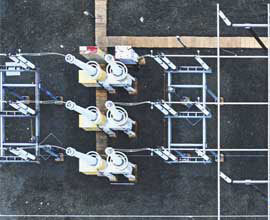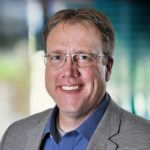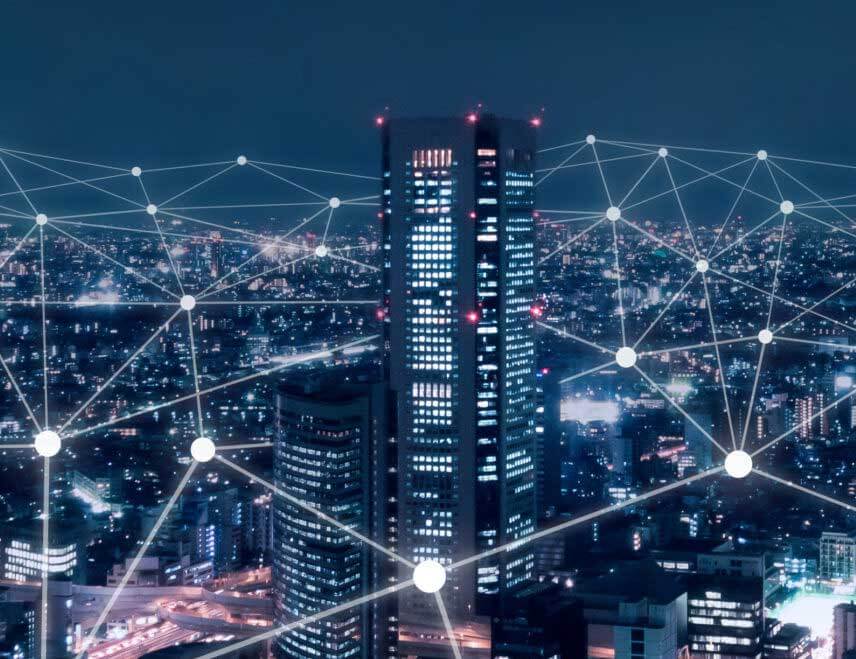Hurricanes, Derechos, 500-Year Floods: Modernizing the Grid to Build in Resiliency and Hardening

June 29, 2021
Modernize Your Grid
As our nation transitions from fossil fuels to renewable energy, there’s been a lot of talk about building reliability into our energy grid. This has led to a wide range of proposed solutions. Some are pushing to slow down the rush to clean energy, while others are investing more heavily into utility-grade battery energy storage systems (BESS) to accelerate the development of other types of energy, such as hydrogen or fusion power.
But an equally, and in my opinion, greater need is to build more resiliency into the U.S. and Canadian electrical grid system. As we face an increasing number of super storms, 500-year flooding events, and even cyberattacks, it is becoming more evident that the North American grid system is vulnerable. Look at what happened in Texas in February 2021 – Winter Storm Uri, brought snow, ice and freezing temperatures that paralyzed Texas’ ERCOT system. According to a report by the University of Houston, 69% of Texans lost power during the storm, 49% lost access to water, and the storm led to the death of “more than a hundred people while producing an estimated $295 billion in damage.”
Many people, myself included, were stunned by the Texas-sized problems caused by Winter Storm Uri. The storm clearly called into question the ability of an electrical grid to withstand such a storm, and it has led to those who manage infrastructure to wonder if their systems are prepared for a changing climate, which could inflict more and more powerful weather events in the future.
Defining Resiliency
Often times we confuse terms such as reliability and resiliency. They’re connected, but they are not the same. In the power industry, reliability is defined as the consistent delivery of power from source to user. Resiliency is the ability to prepare for, and adapt to, changing conditions and withstand and recover rapidly from disruptions. Allow me to add a third term, hardening, which is the ability of a grid to withstand a disruption, such as when straight-line winds or tornados hit a power plant or transmission lines.
It’s important to understand this distinction because when we talk about investing in resiliency, what we’re actually talking about is modernizing the grid to withstand more frequent severe weather events and creating systems within the grid to more quickly fix the grid when it is disrupted.
For example, we’re seeing a growing number of renewables projects that are including utility-scale battery energy storage systems (BESS). The intent of incorporating a BESS into a solar power project is to increase reliability and stability. How we design and build that BESS, including the selection of the battery life, and integrate it with the grid also can define its hardening, and its resilience, too.
“We’re moving to a clean energy future, increasingly powered by renewables and distributed energy resources (DERs), which include distributed renewable generation resources, energy efficiency, energy storage, electric vehicles, and demand-response technologies,” says Scott Bussing, Ulteig’s Market Development Manager – Power for California. “The systems needed to make the electric grid operate safely and effectively are becoming exponentially complex. Utilities are creating the electric grid of the future — one that supports high levels of carbon-free resources and integrates new technologies and services, while being safe, reliable and resilient. A modernized grid is a foundational element to quality of life and to the local economy.”
“Florida has invested heavily in the infrastructure to address hurricanes and outages and other storm recovery efforts for the grid,” adds Tanu Jacob, Ulteig’sMarket Development Manager – Power for the Southeast. “Storms, hurricanes and tornadoes are part of life in Mississippi, Alabama, Florida and Louisiana etc. Grid modernization offers practices that can be incorporated to allow for resiliency and storm hardening.”
Different Regions; Different Solutions
Different regions of the U.S. and Canada face different conditions that put electrical grids at risk of failure. Hurricanes threaten the Gulf Coast and East Coast. Blizzards and severe cold hammer the northern tier of the U.S. and Canada. Earthquakes shake along the West Coast. Droughts and wildfires rage throughout the Western part of the U.S. and Canada. Tornadoes whip throughout the Midwest.
What’s important to note is that as we head toward a future where everything becomes electrified, a hit to the power grid may also affect other infrastructure that people depend upon – water systems, transportation (highways, shipping, rail, public transit), broadband, pipelines, and more.
As such, modernizing the grid for resiliency and hardening in various regions may invite different priorities based on the unique potential environmental risks within in each region. Let’s take a look at several regions across the U.S.:
Midwest – Electric utilities in the Midwest serve a wide range of urban and rural populations, and many are working hard to provide safe, reliable, and resilient service to this diverse set of customers. This requires making the grid smarter to incorporate new generations and storage technologies while also hardening it to handle the ever-changing weather.
When people in other parts of the country think of places in the upper Midwest, such as Minnesota, Iowa or the Dakotas, they often cite our harsh winters. But what many overlook is the threat of tornadoes, significant rain events that dump huge volumes of rain in a short period leading to major flooding, and derechos – widespread, long-lived, straight-line wind storms.
Kyle Whisner, P.E., a line design supervisor from ITC Midwest shared this story about a derecho that packed sustained winds of more than 70 miles per hour, with gusts up to 140 miles per hour, that hit Iowa during August 2020, which knocked out power to parts of Iowa for eight days: “The devastating derecho of August 2020 caused outages affecting more than 30% of the ITC Midwest transmission line system. It was essential to get the electricity flowing as quickly as possible to serve our distribution utilities. Early in the restoration process, ITC Midwest contacted Ulteig to provide engineering support to facilitate the process of completing line design packages so utility crews could move forward with repairing and replacing the lines that were done. The Ulteig team responded quickly to our request for engineering support, was available day and night, and was highly responsive throughout the challenging time. With Ulteig’s support, we restored the power to our distribution utility customers eight days following the massive storm.”
California – California leads the nation in transforming its electrical grid. While the state continues to rely on 200 natural gas power plants, its last nuclear power plant is scheduled to be decommissioned in 2024 and it has just one coal-powered power plant in operation. In 2020, solar PV and solar thermal power plants produced 29,440 gigawatt-hours (GWh) of energy or 15.42 percent of California’s in-state generation portfolio. The state now has 770 operating Solar power plants, with an installed capacity about 13,989 megawatts. Wind energy projects totaling at least 5,535 megawatts (MW) of capacity are operating in California today, providing enough electricity to power more than 2 million California households.
“In California the electric grid has been experiencing a tremendous change over the past two decades. This has been due to an increase in customer expectations, more frequent and visible catastrophic events, new technology, and the pressure to reduce carbon emissions throughout the industry,” adds Dwain Botelho, Senior Market Development Manager – Power for Ulteig in California.
According to Botelho, all of these factors have put significant pressure on the distribution system and their operators. Traditionally, the distribution grid was viewed and operated as a “poles and wire” utility with limited visibility. Today, the distribution system has become a focal point as the nation moves to a more modern grid for the 21st century. While many aspects of the traditional distribution system remain the backbone of the grid’s operation, the conventional approach to operating and maintaining this grid is no longer a viable solution.
“In California, Ulteig is addressing this urgent need for grid modernization with innovative approaches and modern technology,” Botelho adds. “We are partnering with utilities to address adding infrastructure, system reliability, wildfire impact assessments and business risk analysis for capital improvements. As a trusted partner, I think Ulteig’s power customers are realizing greater value from their grid infrastructure investments for the benefit of all stakeholders and the community.”
Grid resiliency efforts in California must address a number of threats that could occur statewide. The most obvious are earthquakes and wildfires, but there’s also heavy snowfall in the Sierra-Nevada mountains, drought conditions (natural gas power plants require water to operate), tornadoes in Central California, and large rainfall events that have caused dramatic and sudden flooding. Long-term, power plants along the California coast will be threatened by sea-level rise and extreme heat, which age power lines, as climate change continues. In some cases, the combination of extreme heat and increased demand for electricity for cooling can lead to catastrophic failure, as when 2,000 distribution line transformers failed during a July 2006 heat wave in California, according to a 2019 report by the Oak Ridge National Laboratory.
Texas – As the largest consumer of electricity in the United States, according to an article on Statista, Texas presents tremendous opportunities in terms of grid modernization as well as system resiliency and reliability.
“It is a complex electric system comprised of municipal and investor-owned utilities, electric cooperatives, and independent power producers,” says Jose Caceres, Ulteig’s Market Development Manager – Power for Texas.
The state’s electrical grid, managed by ERCOT, is especially vulnerable to hurricanes along its Gulf Coast, tornadoes in northern Texas (is what is known as Tornado Alley), extreme heat, and during the winter months, winter storms that have knocked out both power and other utilities, such as water systems.
Colorado – Sarah Beckman, P.E., SMIEEE, who serves as Program Director for Ulteig’s utility clients, provides this perspective about the Colorado market: “Colorado’s focus on grid modernization is driven by several factors: the increasingly disastrous impact of wildfires in our state; state-wide carbon-free commitments; and need to move to an optimized and efficient electric grid. Utilities in Colorado are driving the adoption of carbon-free solutions and distributed energy resources (DERs) to achieve these goals. Colorado has a higher adoption rate of electric vehicles, rooftop solar, and other technologies than other states in the middle U.S.”
“Ulteig is playing a key role in implementing solutions in grid modernization,” says Beckman, “and focusing on high wildfire risk zones across our services. With a solution-driven mindset, we work holistically across our lifeline sectors to benefit the Colorado communities.”
“Of all the states in the US, Colorado may be the best prepared for a genuine, large-scale energy transition,” noted a 2019 article by Vox.com. With more than 300 days of sunlight and bountiful wind, “Colorado has enormous potential for renewable energy, most of which is untapped.” According to the U.S. Energy Information Administration, “since 2010, Colorado’s renewable electricity net generation has more than tripled, led by increased wind and solar, and accounted for 30% of the state’s total generation in 2020. In a separate report, Colorado was noted for its efforts to modernize its electrical grid by the GridWise Alliance, which publishes an annual report called the Grid Modernization Index. The Index ranks each state on grid modernization policies, customer engagement strategies, and deployment of advanced operations technologies.
Southeast (Florida, Georgia, Alabama, Mississippi, South Carolina) – According to a study published in the Proceedings of the National Academy of Sciences, scientists studied tropical storms and hurricanes over a period of 39 years, between 1979 and 2017, and identified a clear trend: Storms are getting stronger in general, and major tropical cyclones are coming more often. This trend is being accelerated by climate change and warming ocean waters.
However, this isn’t the only threat that states along the Gulf Coast face. Rising sea levels in the coming years will also force utilities in Florida, Georgia, and the Carolinas to build in more hardening and resiliency into their power grids. Rising sea levels combined with a storm surge from a hurricane and high tides are starting to set off alarms, particularly in Florida.
In thinking about what the future holds for the Southeast U.S., Tanu Jacob offers these insights: “Grid modernization must allow for resiliency and storm hardening which is not necessarily present in the region. The key is to use solutions and technology to allow the grid to be brought back to the ‘before’ conditions after the impact of these weather events passes through.”
Jacob notes that many utilities, regulators and customers are beginning to realize how necessary it is to not only restore the grid to its previous state, but ensure it remains and continues to be resilient for future events. Utilities also are continually working on identifying and addressing vulnerabilities present on the grid – which is a proactive approach necessary to address resiliency and storm hardening in the Southeast.
Designing for Hardening and Resiliency
With decades of experience working with utilities throughout the United States in modernizing their grids, Ulteig has built a strong understanding of the process that utilities should consider when planning a modernizing project. In the “Grid Modernization Cycle,” the Grid Modernization Team at Ulteig has boiled down the modernization process into four key stages:
1. System Evaluation and Framework Design
2. Communication Network and Data Management
3. Tech Solutions and Field Implementation
4. Data Analytics Processing
One of the most important questions that needs to be asked as part of this process is: “How much is enough to prepare for a major disaster?” As we look at the changing landscape, we know we need to build our systems to be bigger and stronger to withstand a wide range of possible scenarios over the next 35 years. The answer to this often comes back to who’s going to pay to make the grid more resistant.
In planning, the Ulteig Grid Modernization Team will usually take the last “worst problem” that occurred and prepare for a slightly larger problem. After all, no one can afford the absolute worst possible disaster, but we can plan for a diminishing return. In terms of scenario planning, the worst-of-the-worst is going to occur rarely – so it’s important to maintain a balanced approach between overpreparing/overspending and underpreparing/underspending.
“Improvement for grid flexibility and control is necessary for grid resiliency,” Jacob says, “which brings the need for best practices for grid modernization. Grid resiliency and storm hardening practices through grid modernization encompasses an all-hazard approach. The planning and implementation of storm hardening and grid resiliency investments must carefully balance the needs of all involved – utilities, regulators, shareholders, customers and other stakeholders to allow the actual investments to deliver results.”
Learn More
Ulteig proudly serves investor-owned utilities, electric cooperatives, and municipal utility clients of all sizes by understanding needs, responding quickly to requests and delivering high-impact, integrated solutions to meet network expansion and capital improvement requirements. To learn more about Ulteig’s experience and capabilities in helping utilities solve complex problems, visit our Power sector page on Ulteig.com.
Power Up Your Grid Mod Efforts. Ulteig offers one of the most talented Grid Modernization teams in the United States. They have decades of experience that they can leverage for your next project and what makes our team even more unique is most of that experience is at utilities so they better understand you. Find out more about Grid Modernization here!
By Mark Scheid, P.E., Market Director – Power
 Mark Scheid, P.E., is Director for Ulteig’s Power Department. Mark is an experienced business development engineer with 20 years of experience in working with utility companies.
Mark Scheid, P.E., is Director for Ulteig’s Power Department. Mark is an experienced business development engineer with 20 years of experience in working with utility companies.
WHAT MAKES ULTEIG DIFFERENT?
From global energy producers to locally funded cities and private developers to government agencies, the clients we serve encompass a broad range of relationships and projects. Find out why Ulteig is a leader in the engineering industry.
Contact Us

